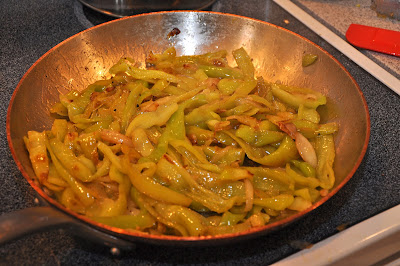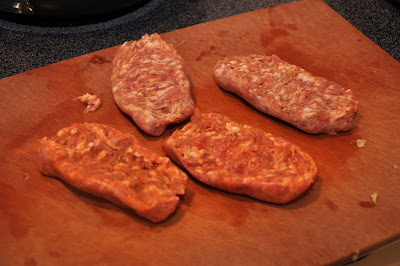What would summer be without this perennial Italian-American favorite? It's hard to imagine an Italian street fair without the enticing aroma of sausages being grilled on portable barbecues while peppers and onions are sizzling away on a near-by griddle. Isn't just the thought of it enough to make you hungry? Here's my take on this classic.
First you make a kind of peperonata—the fried peppers and onions that make for such a popular summer side dish—by taking a nice heap of 'frying peppers', the thin, longish light-green peppers that Italians call friggitelli, cutting off their tops and slicing them in half from top to bottom. Remove the seeds and any white ribs you find inside. (This kind of pepper has a lot less than regular bell peppers, but you will still find some.) Then slice them vertically into thin strips:
Measurements don't much matter, but I find that a half pound (250g) of peppers per person is about right. That may look like a lot of peppers to begin with, but they reduce considerably while cooking.
Then peel an onion and slice it in half from top to bottom. Trim off the root and then slice each half vertically into thin but not paper-thin slices. Make sure you slice the onion vertically—that is, from root to tip with the grain. If you slice onion horizontally—across the grain—the onion pieces will 'melt' into the dish as it cooks. That's what you want for most dishes where the onion is there purely for it savory flavor. But in this dish, the onion is more than just a flavoring, it is a component in its own right: put another way, it's not just part of the harmony, it has a solo:
The exact amounts don't much matter, but in this dish the peppers are the real star, so one medium onion is enough for a pound (500g) of peppers. Now heat a skillet and when it is hot, add a generous amount of olive oil. Before the oil begins to smoke, add you sliced peppers and onions. Mix well with some tongs (or a spatula) and lower the heat.
Maintain a moderate flame so that the vegetables are sizzling nicely in the oil without browning too much. As they cook, the peppers and onions will reduce considerably. Hold off seasoning the dish, as adding salt early on will tend to 'melt' the onion. Instead, season well about halfway through the cooking time (which is to say, after 10-15 minutes) with salt and pepper. Make sure that the vegetables are nicely coated with olive oil—they should glisten like a salad. If they are a bit dry, don't hesitate to add some more oil. When the peppers are just about tender—and they should be fully tender, neither crisp-tender nor mushy—turn up the heat and let the vegetables caramelize, mixing often so they brown nicely but don't burn. Then take them off the heat and cover them. Let them 'rest' like that while you turn to the sausages.
Now it's time to grill the sausages. As you probably know, when cooked whole it is best to prick sausages here and there with the tip of a paring knife or the prongs of a fork. This prevents the filling from 'exploding' out of its skin as it cooks. But there is another way to treat sausages before grilling: butterfly them by slitting them down one side and opening them like a book. This not only allows the sausages to cook more quickly, but exposes more of the sausage to caramelization. If you like the taste of crisy pork, you are bound to like this technique. Your sausages should like something like this before cooking:
Then place the sausages on a hot grill, skin side down first, turning them from time to time, When they are nicely crisp and brown on both sides, serve them on top of the peppers and onions, which you will have laid out on a platter as a bed for the sausages to lie on.
NOTES: It may come as a surprise, but sausages and peppers is not a particularly common dish in Italy. Although it is not unheard of to add sausages to cook along with a peperonata, the dish has nothing like the iconic place in Italian cooking that it does in Italian-American tradition. You will look in vain in the major Italian cookbooks for sausages and peppers, even those specializing in Neapolitan or southern Italian cooking. In southern Italy, it is far more common to pair sausages and broccoletti or cime di rapa, known as broccoli rabe in English. Typical of Neapolitan cooking is the use of the young shoots of the same plant, which are known as friarelli. (NB: Confusingly, frying peppers or friggitelli are sometimes also called friarelli.) In the north, you are more likely to find sausage cooked with Savoy cabbage, radicchio or Tuscan kale rather than peppers. None of which to belittle this dish. On the contrary, the match of sausage and peppers is a delicious match, one that was really meant to be.
A common variation of this dish is the addition of tomato or some tomato sauce to the peperonata when it is about halfway done. By the time the tomato reduces the peppers should also be done. Some people like to add a bit of red pepper flakes as well, although I don't recommend it. If you like some spice, use 'hot' sausages—although I usually not very partial to them, they really go well in this dish. You can also add just a pinch of oregano to the peperonata, but not too much, as the flavor of oregano is very pronounced. But do avoid the use of too many dried herbs or that awful invention called 'garlic powder', which makes everything it touches taste rancid. The elements of this dish—the sausages, onions and peppers—all have tremendous flavor. They don't really need the 'help' of artificial ingredients.
If you don't have a grill handy, the sausages can be fried in the same skillet. You can brown them at the very beginning, then remove them to make your peperonata, then add them back to the skillet when the peppers are almost tender to finish cooking. Or, when the peppers are almost tender, you can push the peperonata to the sides of the skillet and brown the sausages in the center, then mix everything up and let it cook gently until the sausages are cooked through and the peppers are tender.
Sausages and peppers are often eaten as the filling for a 'hero' sandwich, but I like it just as it is, with some crusty bread on the side. If you have leftovers, the dish reheats well; it also makes a fantastic filling for a frittata. Some people also use it as a condimento for pasta. Not my cup of tea, as they say, but if you do use it this way, make sure to cut up the sausage into bite-sized pieces. Here a little tomato sauce helps give it a saucy consistency that works well with pasta.

